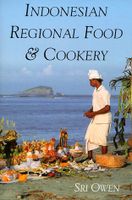Advertisement
TéMPé, TéMPéH
By Sri Owen
Published 1994
A preparation of boiled soya beans, held together by a mould which digests parts of the beans that the human digestive system cannot cope with and also gives the témpé a mild, nutty flavour. Témpé is made and sold in slabs or cakes about 2.5 cm/1 inch thick. It must be boiled or fried before being eaten, and is rather tasteless by itself, but it makes an excellent basis for a wide variety of savoury and sweet dishes, hamburgers, sauces, dips, ice creams, etc. In Java and some other parts of Indonesia it is a valuable source of protein, but in the past, because it was associated with hard times and poverty, its status as a food was very low. It is becoming moderately popular in the USA and Europe as a vegetarian and health food, and can be bought, usually frozen, from organic and health food shops. It is also quite easy to make témpé at home if you have a supply of the ragi, or starter. The usual starter is a yeast called Rhizopus oligosporus. Instructions are given in


